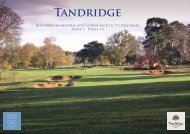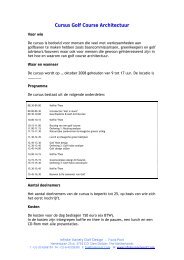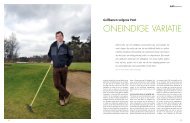restoring Royal Hague's greens - Infinite Variety Golf Design
restoring Royal Hague's greens - Infinite Variety Golf Design
restoring Royal Hague's greens - Infinite Variety Golf Design
You also want an ePaper? Increase the reach of your titles
YUMPU automatically turns print PDFs into web optimized ePapers that Google loves.
OPPOSITE ABOVE LEFT<br />
<strong>Royal</strong> Hague: A view of the<br />
devilish, short-mown grassy<br />
hollows behind the 355-<br />
metre par-4 second hole’s<br />
new green. They are prime<br />
examples of the type of<br />
‘hazard’ that Colt and Alison<br />
were keen to utilise; namely,<br />
being difficult enough for<br />
good players and ‘forgiving’<br />
for less-talented golfers.<br />
(Photograph by Frank Pont.)<br />
OPPOSITE ABOVE RIGHT<br />
<strong>Royal</strong> Hague: The green of<br />
the 328-metre par-4 ninth<br />
hole lies high atop a dune<br />
ridge, guarded by a<br />
deceptively difficult bunker.<br />
The unpredictable wind is<br />
always a vital factor in<br />
choosing one’s club for the<br />
approach. (Photograph by<br />
Frank Pont.)<br />
OPPOSITE BELOW <strong>Royal</strong> Hague:<br />
The green of the 202-metre<br />
par-3 fourth hole, as seen<br />
from the back tees, still<br />
provides players with a<br />
breathtaking view of the<br />
dunes and, occasionally,<br />
passing ships on the North<br />
Sea. It doesn’t, however,<br />
diminish the threat posed by<br />
the three bunkers, or the<br />
OOB along the right-hand<br />
side of the hole. (Photograph<br />
by Frank Pont.)<br />
In <strong>restoring</strong> the original <strong>greens</strong> we took<br />
great care to recreate the exact playing surfaces;<br />
we also repaired some areas that had<br />
clearly changed over the years. One example<br />
was an enclosed depression in the thirteenth<br />
green that clearly was the result of consolidation<br />
of the soil over the previous decennia.<br />
Restoring the original <strong>greens</strong> was rewarding;<br />
the highlight of our project, however, was<br />
designing and building the new ones. The<br />
following text describes some of the thoughts<br />
and issues that went into that process.<br />
The first of the newly constructed <strong>greens</strong><br />
was on the second hole. The previous green<br />
had been very small: all upward-sloping, and<br />
it had a ‘band-like’ dune behind it that<br />
appeared artificial. The hole is a mediumlength<br />
par-4 where, due to a massive valley in<br />
front of the green, the shot into the green is<br />
either approached ‘blindly’ with a short-iron,<br />
or to a visible target with a medium-length<br />
iron. The goal was to give the player hitting<br />
into the green with the longer shot more<br />
room to land on the green, while making the<br />
longer hitter’s ‘blind’ wedge shot into the<br />
green an even harder proposition. Another<br />
goal was to remove as much visual backdrop<br />
to the green as possible, so that better players<br />
would have a hard time judging the distance<br />
to the green.<br />
The new green we built was almost fifty<br />
per cent larger. The front of the green<br />
remained the old surface, while a new back<br />
section was added—flat for the first portion,<br />
sloping away from the player, thereafter.<br />
Grassy hollows were installed behind the<br />
green.<br />
Another new green was installed at the<br />
seventh hole, where the main problem again<br />
was that the green was too small. The solution<br />
here was to lower the green surface by<br />
about a metre, which created just enough<br />
extra space on the right side to make the total<br />
green surface large enough. A welcome, extra<br />
dimension of expanding the green to the<br />
right has become apparent: it makes the teeshot<br />
even more strategic, for any drive that is<br />
not sufficiently leftward on the fairway, leaves<br />
a daunting ‘blind’ shot to the green.<br />
<strong>Royal</strong> Hague’s thirteenth green provided<br />
quite a different challenge. The supplanted<br />
green was grossly out of character with its<br />
two-tiered structure and double-flanking<br />
bunkering left and right of the green—clear<br />
indications that it wasn’t an original green.<br />
Because the hole is a difficult par-4 that is<br />
usually played into the wind, we were keen to<br />
provide players with more space to land a<br />
long-iron on the green, and to improve the<br />
odds of golf balls staying on the surface. This<br />
was achieved by moving the green rearward,<br />
making it significantly longer in the process.<br />
The new green is defended by a bunker on<br />
the front, right side and flanked on the left by<br />
a little ‘nasty’ hump at the entrance to the<br />
green. The entire left-hand side and back of<br />
the green is defended by three, huge grassy<br />
hollows that gather most of the less-accurate<br />
shots of the players. Putting on this long,<br />
upward-sloping green is far from easy, since<br />
it plays ‘tricks’ with your eyes—from both the<br />
front and the rear of the green, it seems the<br />
green slopes to the left. Obviously, this is a<br />
physical impossibility.<br />
The sixteenth hole is a short par-4, which,<br />
from the men’s tee, is driveable for the bighitters.<br />
The green had a large pine tree right<br />
next to the green, which many members<br />
liked, but it wasn’t present when the course<br />
was built. It certainly didn’t fit Alison’s design<br />
philosophy. The most negative aspect of it<br />
240 GOLF ARCHITECTURE: A WORLDWIDE PERSPECTIVE – VOLUME FIVE









